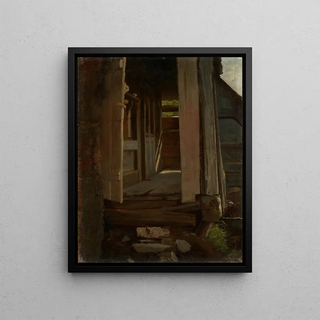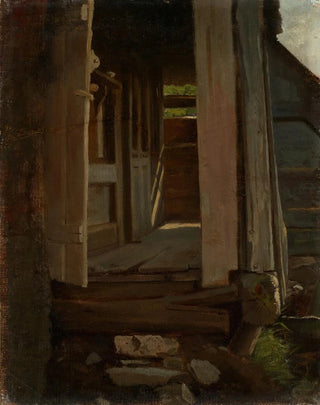Art print | Entrance of a house in the Black Forest - Hans Thoma


View from behind

Frame (optional)
Entry of a house in the Black Forest - Hans Thoma – Captivating introduction
The art print "Entry of a house in the Black Forest" by Hans Thoma transports us to a universe where nature and architecture meet harmoniously. This painting, imbued with serenity, evokes not only the beauty of German landscapes but also the simplicity and authenticity of rural life. Gazing at this scene, one feels invited to explore the nooks of the Black Forest, to immerse oneself in its mysteries and legends. The soft light bathing the house, the meticulous details of the surrounding trees, and the warm color palette create an atmosphere of calm and nostalgia. This art print is much more than a simple representation; it is an open window to a world where time seems suspended, a refuge for the soul.
Style and uniqueness of the art print
Hans Thoma's style is characterized by a naturalist approach, where each element is carefully observed and rendered with remarkable precision. In "Entry of a house in the Black Forest," the artist uses subtle nuances to capture variations in light and shadow, thus emphasizing the depth of the scene. The textures of the materials, whether the wood of the house or the foliage of the trees, are rendered with a delicacy that reflects a true love for nature. Thoma manages to create an almost palpable atmosphere, where one can almost smell the scent of the undergrowth and hear the whisper of the wind. His ability to fuse landscape with architecture reveals a deep understanding of the harmony between man and his environment, making this art print an emblematic example of his style.
The artist and his influence
Hans Thoma, born in 1839, is a major painter of the German Romantic movement. His career is marked by an incessant quest for authenticity and natural beauty. Influenced by the landscapes of his youth, he develops a particular sensitivity for rural scenes and popular traditions. Thoma has established himself as a master of landscape painting, but also as a talented portraitist. His work is deeply rooted in German culture, and he played a key role in the development of

Matte finish

View from behind

Frame (optional)
Entry of a house in the Black Forest - Hans Thoma – Captivating introduction
The art print "Entry of a house in the Black Forest" by Hans Thoma transports us to a universe where nature and architecture meet harmoniously. This painting, imbued with serenity, evokes not only the beauty of German landscapes but also the simplicity and authenticity of rural life. Gazing at this scene, one feels invited to explore the nooks of the Black Forest, to immerse oneself in its mysteries and legends. The soft light bathing the house, the meticulous details of the surrounding trees, and the warm color palette create an atmosphere of calm and nostalgia. This art print is much more than a simple representation; it is an open window to a world where time seems suspended, a refuge for the soul.
Style and uniqueness of the art print
Hans Thoma's style is characterized by a naturalist approach, where each element is carefully observed and rendered with remarkable precision. In "Entry of a house in the Black Forest," the artist uses subtle nuances to capture variations in light and shadow, thus emphasizing the depth of the scene. The textures of the materials, whether the wood of the house or the foliage of the trees, are rendered with a delicacy that reflects a true love for nature. Thoma manages to create an almost palpable atmosphere, where one can almost smell the scent of the undergrowth and hear the whisper of the wind. His ability to fuse landscape with architecture reveals a deep understanding of the harmony between man and his environment, making this art print an emblematic example of his style.
The artist and his influence
Hans Thoma, born in 1839, is a major painter of the German Romantic movement. His career is marked by an incessant quest for authenticity and natural beauty. Influenced by the landscapes of his youth, he develops a particular sensitivity for rural scenes and popular traditions. Thoma has established himself as a master of landscape painting, but also as a talented portraitist. His work is deeply rooted in German culture, and he played a key role in the development of






